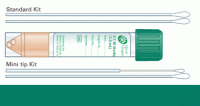
Test Name: Mycoplasma hominis/Ureaplasma Culture
Test Code: 871
CPT Code: 87109
Methodology: Culture
Clinical Significance: Ureaplasma urealyticum and Mycoplasma hominis are primarily associated with genital tract colonization and disease in adults and respiratory tract colonization and disease in newborns. Though controversial, these organisms have been associated with endometritis, chorioamnionitis, premature rupture of membranes, stillbirth, premature birth, low birth weight, post-partum infections, and infertility. Of particular concern is the causal relationship between central nervous system infections in the premature newborn and U. urealyticum.
Alternative Names: Culture Mycoplasma; Culture, Mycoplasma hominis; Hominis; M hominis Culture; M. hominis & Ureaplasma Culture; Myco/T-Strains; Myco/Urea Cult; Mycoplasma and Ureaplasma Culture; Mycoplasma Culture, General; Mycoplasma hominis Culture; Mycoplasma/Ureaplasma; Ureaplasma; Ureaplasma Culture; Ureaplasma/Mycoplasma
Preferred Specimen:
Urogential (Vaginal, Cervical, Urethral Swabs, or Vaginal Secretions)
Urine
Sterile Body Fluids
Tissue
Wound Swab
Respiratory (Sputum, Bronchial Washings, Tracheobronchial Secretions, Bronchial Alveolar Lavage, Nasopharyngeal or Throat Swabs)
ONLY ACCEPTABLE FROM CHILDREN UNDER 1 YEAR OLD
Urogenital:
Collect in VCM medium (green-cap) tube.
Cervical Collection
- Do not use lubricant during procedure.
- Remove mucous from the exocervix with the large Rayon swab provided
- Discard the swab after use and use the smaller swab to obtain exudate from the cervical glands and os
- Roatate the swab in the cervical os 3-5 seconds
- Remove swab carefully avoiding the vaginal wall and place the swab in the VCM transport tube, breaking the shaft at the molded mark
- The length of the swab should fit easily into the tube. Do not force the swab into the tube
- Recap tightly. Store on dry ice and send to the laboratory as soon as possible
Urethra Collection
- Collect specimens at least 2 hours before patient has urinated
- Insert collection swab into urethra 2 to 4 cm and rotate gentaly leaving it in place 1 to 2 seconds
- Withdraw/remove swab carefully and place in the VCM tranport tube, breaking the shaft at the molded mark
- The length of the swab should fit easily into the tube. Do not force the swab into the tube
- Repap tighly. Store on dry ice and send to the laboratory as soon as possible
Urine:
- Centrifuge urine at 3000RPM for 15 minutes
- Suspend sediment in VCM medium (green-cap) tube
- If the specimen is not centrifuged submit a 1:1 volume of urine in VCM
- Recap tightly. Store on dry ice and send to the laboratory as soon as possible
Sterile Body Fluids:
- Submit a 1:1 volume of body fluid in VCM
- Recap tightly. Store on dry ice and send to the laboratory as soon as possible
Tissue:
- Submit a 1:1 volume of tissue in VCM
- Recap tightly. Store on dry ice and send to the laboratory as soon as possible
Wound Swab:
- Obtain specimen from the selected site
- Place the collection swab in the VCM transport tube, breaking the shaft at the molded mark
- The length of the swab should fit easily into the tube. Do not force the swab into the tube
- Recap tightly, store on dry ice and send
Respiratory –
ONLY ACCEPTABLE FROM CHILDREN UNDER 1 YEAR OLD
- Specimens other than Nasopharyngeal submit a 1:1 volume of sample in VCM (See below for Nasopharyngeal collection instructions)
- Recap tightly. Store on dry ice and send to the laboratory as soon as possible
Nasopharyngeal Collection:
- Obtain specimen using only the mini-tip swab provided in this kit
- Push forward using gentle downward pressure to keep the swab on the floor of the nasal cavity until the tip reaches the posterior wall of the nasopharynx
- Rotate gently for a few seconds and remove swab and place in the VCM medium
- Break the swab shaft at the molded mark
- Recap tightly. Store on dry ice and send to the laboratory as soon as possible
Preferred Volume: 1mL or 1 swab
Transport Container: VCM (Green-Cap) Tube;
DO NOT USE M4RT - THE ROOM TEMPERATURE FORMULA
Transport Temperature: Frozen on Dry Ice (–70°C)
Ship on dry ice.
Specimen Stability: Frozen at –70°C: 30 days
Rejection Criteria: Specimens collected on wooden shafted swabs or cotton swabs; Specimen received in expired transport medium; Tissue specimen in formalin; Urine containing any preservatives; Specimens received in M4RT transport medium; Raw specimens
For additional supply or collection device information, please contact DLO's Customer Services at (800) 891-2917, option 2.
The CPT codes provided are based on AMA guidelines and are for informational purposes only. CPT coding is the sole responsibility of the billing party. Please direct any questions regarding coding to the payor being billed.
